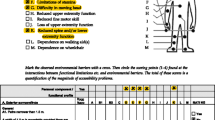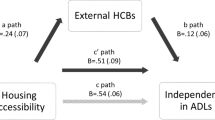Abstract
Aims
Good housing solutions are important for the ageing population in order to promote health and maintain functional ability. The objective of this study was to investigate whether and how objective and perceived aspects of housing were related to perceived health among ADL independent and ADL dependent groups of older, single-living people within three national samples.
Methods
The current study was based on national samples (German, n = 450; Latvian, n = 303; Swedish, n = 397) from the European ENABLE-AGE Project, using data on ADL dependence, perceived health, objective and perceived aspects of housing. Descriptive statistics, correlations and multivariate ordinal regression models were used to analyze the data.
Results
The participants in the ADL dependent groups generally were older, had more functional limitations and perceived their health as poorer compared to ADL independent groups. With regard to perceived housing, usability as well as meaning of home indicators was often lower in the ADL dependent groups, housing satisfaction was at the same level while housing-related external control beliefs were higher. The differences among the national samples were highly significant for both ADL groups, for all variables except number of outdoor environmental barriers in the ADL independent groups. The relations between perceived health on one hand and objective and perceived aspects of housing on the other show great diversities among the ADL groups and the national samples.
Conclusions
The results serve to alert health care practitioners that it is important to draw attention to how older people perceive their housing situation and to the fact that different levels of functional independence demand different interventions.
Similar content being viewed by others
References
Iwarsson S, Wahl H-W, Nygren C et al (2007) Importance of the home environment for healthy aging: conceptual and methodological background of the European ENABLE-AGE Project. Gerontologist 47(1):78–84
Oswald F, Wahl H-W (2004) Housing and health in later life. Rev Environ Health 19(3–4):223–252
Malmgren Fänge A, Oswald F, Clemson L, Eds. Aging in place in late life: Theory, methodology, and intervention. J Aging Res Special Issue 2012: 1–2
Wahl HW, Iwarsson S, Oswald F (2012) Aging well and the environment: toward an integrative model and a research agenda for the future. Gerontologist 52(1):306–313
Rowles GD, Oswald F, Hunter EG (2004) Interior living environments in old age. In: Wahl HW, Scheidt R J, Windley PG (eds) Annu Rev Gerontol Geriatr. Issue on ageing in context: socio- physical environments, vol 23. Springer, New York, pp 167–237
Howden-Chapman P (2004) Housing standards: a glossary of housing and health. J Epidemiol Community Health 58:162–168. doi:10.1136/jech.2003.011569
Iwarsson S (2003) Assessing the fit between older people and their physical home environments: an occupational therapy research perspective. In: Wahl HW, Scheidt R, Windley P (eds) Annu Rev Gerontol Geriatrics, 23, Issue on Ageing in Context: Socio-Physical Environments. Springer, New York, pp 83–109
Iwarsson S, Ståhl A (2003) Accessibility, usability and universal design—positioning and definition of concepts describing person–environment relationships. Disabil Rehabil 25:57–66
Oswald F, Schilling O, Wahl H-W, Fänge A, Sixsmith J, Iwarsson S (2006) Homeward bound: introducing a four domain model of perceived housing in very old age. J Environ Psychol 26:187–201
Oswald F, Kaspar R (2012) On the quantitative assessment of perceived housing in later life. J Hous Elderly 2012(26):72–93
Pinquart M, Burmedi D. Correlates of residential satisfaction in adulthood and old age: a meta-analysis. In: Wahl HW, Scheidt R, Windley PG (eds) Annu Rev Gerontol Geriatr, 23, Issue on Ageing in Context: Socio-Physical Environments. Springer, New York, 195–222
Fänge A, Iwarsson S (2003) Accessibility and usability in housing—construct validity and implications for research and practice. Disabil Rehabil 25:1316–1325
Oswald F, Wahl H-W, Martin M, Mollenkopf H (2003) Toward measuring proactivity in person–environment transactions in late adulthood: the housing-related Control Beliefs Questionnaire. J Hous Elderly 17:135–152
Roderick JL (2004) Housing, health and well-being: moving forward. Rev Environ Health 19(3–4):161–176
Sundsvall Statement on Supportive Environments for Health (1991) Third International Conference on Health Promotion, Sundsvall, Sweden, pp 9–15
Scheidt RJ, Norris-Baker C (2003) The general ecological model revisited: Evolution, current status, and continuing challenges. In: Wahl HW, Scheidt RJ, Windley PG (eds) Annu Rev Gerontol Geriatr, 23, Issue on Ageing in Context: Socio-Physical Environments. Springer, New York, pp 34–58
Oswald F, Wahl H-W, Schilling O et al (2007) Relationships between housing and healthy ageing aspects in very old age: results from the European ENABLE-AGE Project. Gerontologist 47(1):96–107
Iwarsson S (2005) A long-term perspective on person-environment fit and ADL dependence among older Swedish adults. Gerontologist 45:327–336
Werngren-Elgström M, Carlsson G, Iwarsson S (2008) Changes in person environment fit and ADL dependence among older Swedish adults—a 10-year follow-up. Aging Clin Exp Res 20:469–478
Nygren C, Oswald F, Iwarsson S et al (2007) Relationships between objective and perceived housing in very old age: results from the ENABLE-AGE Project. Gerontologist 47(1):85–95
Iwarsson S, Horstman V, Slaug B (2007) Housing matters in very old age-yet differently due to ADL dependence level differences. Scand J Occup Ther 14(1):3–15
Iwarsson S, Wahl H-W, Nygren C (2004) Challenges of cross-national housing research with older people: lessons learned from the ENABLE-AGE Project. Europ J Ageing 1:79–88
Iwarsson S, Nygren C, Slaug B (2005) Cross-national and multi-professional inter-rater reliability of the Housing Enabler. Scand J Occup Ther 12:29–39
Ware JE (1992) SF-36 health survey update. Spine 24:3130–3139
Sonn U, Hulter-Åsberg K (1991) Assessment of activities of daily living in the elderly. A study of a population of 76-year-olds in Gothenburg, Sweden. Scand J Rehabil Med 23:193–202
Iwarsson S, Isacsson Å (1997) Quality of Life in the elderly population: an example exploring interrelationships among subjective well-being, ADL dependence, and housing accessibility. Arch Gerontol Geriatr 26:71–83
Iwarsson S, Slaug B (2001) The housing enabler. An instrument for assessing and analysing accessibility problems in housing. Veten & Skapen HB & Slaug Data Management, Nävlinge och Staffanstorp
Folstein MF, Folstein SE, McHugh PR (1975) “Mini-mental state”. A practical method for grading the cognitive state of patients for the clinician. J Psychiatr Res 12(3):189–198
Eccles M, Clarke J, Livingstone M, Freemantle N, Mason J (1998) North of England evidence based guidelines development project: guideline for the primary care management of dementia. BMJ 317(7161):802–808
Iwarsson S, Isacsson A (1996) Housing standards, environmental barriers in the home, and subjective general apprehension of housing situation among the rural elderly. Scand J Occup Ther 3:52–61
Fänge A, Iwarsson S (2005) Changes in ADL dependence and aspects of usability following housing adaptation—a longitudinal perspective. Am J Occup Ther 59:296–304
Heywood F, Oldman C, Means R (2002) Housing and home in later life. Oxford University Press, Buckingham
McCullagh P, Nelder JA (1983) Generalized linear models. Chapman Hall, London
Hosmer DW, Lemeshow S (1989) Applied logistic regression. Wiley, New York
Wahl HW, Fange A, Oswald F, Gitlin LN, Iwarsson S (2009) The home environment and disability-related outcomes in ageing individuals: what is the empirical evidence? Gerontologist 49(3):355–367
Iwarsson S, Horstmann V, Oswald F, Wahl H-W (2010) Sociocultural care, service context, and IADL dependence among very old European women. Top Geriatr Rehabil 26(1):32–45
Baltes PB, Smith J (1999) Multilevel and systemic analyses of old age: theoretical and empirical evidence for a fourth age. In: Bengtson VL, Ruth JE, Schaie KW (eds) Handbook of theories of aging. Springer, New York, pp 153–173
Kono A, Fujita T, Tsumura C, Kondo T, Kushiyama K, Rubenstein LZ (2009) Preventive home visit model targeted to specific care needs of ambulatory frail elders: preliminary report of a randomized trial design. Aging Clin Exp Res 21:167–173
Ahn M, Hegde AL (2011) Perceived aspects of home environment and home modifications by older people living in rural areas. J Hous Elderly 25(1):18–30. Available at: http://dx.doi.org/10.1080/02763893.2011.545735. Accessed 02 May 2012
Acknowledgments
This study was accomplished within the context of the Centre for Ageing and Supportive Environments (CASE), at Lund University, funded by the Swedish Council for Working Life and Social Research. The original project was funded by the European Commission (The ENABLE-AGE Project, QLRT-2001-00334).
Conflict of interest
None.
Author information
Authors and Affiliations
Corresponding author
Rights and permissions
About this article
Cite this article
Tomsone, S., Horstmann, V., Oswald, F. et al. Aspects of housing and perceived health among ADL independent and ADL dependent groups of older people in three national samples. Aging Clin Exp Res 25, 317–328 (2013). https://doi.org/10.1007/s40520-013-0050-9
Received:
Accepted:
Published:
Issue Date:
DOI: https://doi.org/10.1007/s40520-013-0050-9




